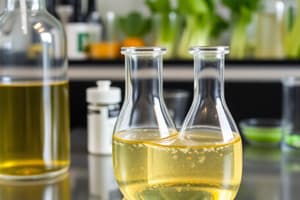Podcast
Questions and Answers
What is the process of using oxygen to break down glucose and produce energy in the form of ATP called?
What is the process of using oxygen to break down glucose and produce energy in the form of ATP called?
Aerobic respiration
What type of respiration does not use oxygen to break down glucose?
What type of respiration does not use oxygen to break down glucose?
Anaerobic respiration
What is the electron acceptor used in anaerobic respiration instead of oxygen?
What is the electron acceptor used in anaerobic respiration instead of oxygen?
Nitrate or sulfur
What is the process that does not use an electron acceptor and does not produce ATP, but instead produces organic molecules such as ethanol or lactate?
What is the process that does not use an electron acceptor and does not produce ATP, but instead produces organic molecules such as ethanol or lactate?
Which sugar degradation pathway is the most common and produces two molecules of pyruvate from one molecule of glucose?
Which sugar degradation pathway is the most common and produces two molecules of pyruvate from one molecule of glucose?
What are the three main types of organisms that carry out aerobic respiration?
What are the three main types of organisms that carry out aerobic respiration?
What is the main product of the EMP pathway from the degradation of glucose?
What is the main product of the EMP pathway from the degradation of glucose?
Why is anaerobic respiration less efficient than aerobic respiration?
Why is anaerobic respiration less efficient than aerobic respiration?
What is the main difference between fermentation and respiration in terms of energy production?
What is the main difference between fermentation and respiration in terms of energy production?
In what type of environment can anaerobic respiration still provide energy to organisms?
In what type of environment can anaerobic respiration still provide energy to organisms?
What is the main difference between the products of fermentation and respiration?
What is the main difference between the products of fermentation and respiration?
What is the purpose of the sugar degradation pathways in microorganisms?
What is the purpose of the sugar degradation pathways in microorganisms?
What are the two main products of the Entner-Doudoroff pathway?
What are the two main products of the Entner-Doudoroff pathway?
What does the pentose phosphate pathway produce?
What does the pentose phosphate pathway produce?
Where does the TCA cycle occur?
Where does the TCA cycle occur?
What are the high-energy molecules produced by the TCA cycle?
What are the high-energy molecules produced by the TCA cycle?
Where does the electron transport chain (ETC) transfer electrons to?
Where does the electron transport chain (ETC) transfer electrons to?
What is the main purpose of the electron transport chain?
What is the main purpose of the electron transport chain?
What are the four protein complexes that compose the electron transport chain?
What are the four protein complexes that compose the electron transport chain?
What is electron transport phosphorylation (ETP) and how does it produce ATP?
What is electron transport phosphorylation (ETP) and how does it produce ATP?
What are uncouplers and how do they affect the ETC?
What are uncouplers and how do they affect the ETC?
What are inhibitors and how do they affect the ETC?
What are inhibitors and how do they affect the ETC?
What are some key differences between the mitochondrial and bacterial ETC?
What are some key differences between the mitochondrial and bacterial ETC?
Flashcards are hidden until you start studying




